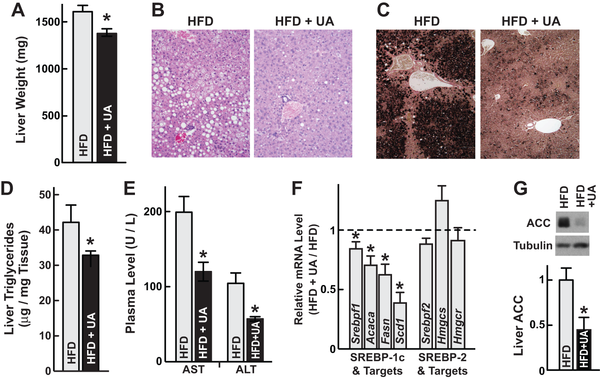Obviously ursolic acid, a lipophilic pentacyclic triterpenoid that contributes to the waxy coats on fruits and various herbs, can't be a license to eat ice cream and pizza every day but it seems to increase the amount of muscle and brown fat, two tissues recognized for their calorie-burning properties. Until recently, it was believed that only infants had brown fat, which then disappeared during childhood, but improved imaging techniques have shown that adults do retain a very small amount of the substance - mostly in the neck and between the shoulder blades. Some studies have linked increased levels of brown fat with lower levels of obesity and healthier levels of blood sugar and blood lipid, leading to the suggestion that brown fat may be helpful in preventing obesity and diabetes.
The study had mice on a high-fat diet over a period of several weeks. Half of the animals also received ursolic acid in their high-fat food. Mice whose diet included ursolic acid actually ate more food than mice not getting the supplement and there was no difference in activity between the two groups. Despite this, the ursolic acid-treated mice gained less weight and their blood sugar level remained near normal. Ursolic acid-treated mice also failed to develop obesity-related fatty liver disease, a common and currently untreatable condition that affects about one in five American adults.

Mice were provided ad libitum access to high fat diet (HFD) lacking or containing ursolic acid (UA) for 6 weeks. UA concentrations were 0.27% (B–C and E) or 0.14% (A, D and F–G). Data are means ± SEM. P<0.05 by t-test. (A) Liver weights. n≥12 mice per diet. (B) Liver H&E-stained sections. 20x magnification. (C) Liver osmium-stained sections, 10x magnification. (D) Hepatic triglyceride content. n = 5 mice per diet. (E) Plasma aspartate aminotransferase (AST) and alanine aminotransferase (ALT) levels. n = 5 mice per diet. (F) Liver mRNA levels were determined using qPCR. Levels in UA-treated mice were normalized to the average levels in mice fed HFD lacking ursolic acid, which were set at 1. n = 10 mice per diet. (G) Livers were harvested and subjected to SDS-PAGE and immunoblot analysis with anti-ACC and anti-tubulin antibodies. Upper: representative immunoblots. Lower: ACC and tubulin levels were quantitated with densitometry. In each mouse, the ACC/tubulin ratio was normalized to the average ACC/tubulin ratio in mice fed HFD lacking ursolic acid. n = 6 mice per diet. Credit: doi:10.1371/journal.pone.0039332.g004
"From previous work, we knew that ursolic acid increases muscle mass and strength in healthy mice, which is important because it might suggest a potential therapy for muscle wasting," said Christopher Adams, M.D., Ph.D., UI associate professor of internal medicine at the University of Iowa. "In this study, we tested ursolic acid in mice on a high-fat diet -- a mouse model of obesity and metabolic syndrome. Once again, ursolic acid increased skeletal muscle. Interestingly, it also reduced obesity, pre-diabetes and fatty liver disease. Since muscle is very good at burning calories, the increased muscle in ursolic acid-treated mice may be sufficient to explain how ursolic acid reduces obesity. However, we were surprised to find that ursolic acid also increased brown fat, a fantastic calorie burner. This increase in brown fat may also help protect against obesity."
Further study showed that ursolic acid consumption increased skeletal muscle, increasing the animals' strength and endurance, and also boosted the amount of brown fat. Because both muscle and brown fat burn calories, the researchers investigated energy expenditure in the mice and showed that ursolic acid-fed mice burned more calories than mice that didn't get the supplement.
"Our study suggests that ursolic acid increases skeletal muscle and brown fat leading to increased calorie burning, which in turn protects against diet-induced obesity, pre-diabetes and fatty liver disease," Adams says. "Brown fat is beneficial and people are trying to figure out ways to increase it. At this point, we don't know how ursolic acid increases brown fat, or if it increases brown fat in healthy mice. And, most importantly, we don't know if ursolic acid will benefit people. Our next step is to determine if ursolic acid can help patients."
Citation: Kunkel SD, Elmore CJ, Bongers KS, Ebert SM, Fox DK, et al. (2012) Ursolic Acid Increases Skeletal Muscle and Brown Fat and Decreases Diet-Induced Obesity, Glucose Intolerance and Fatty Liver Disease. PLoS ONE 7(6): e39332. doi:10.1371/journal.pone.0039332





Comments